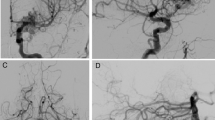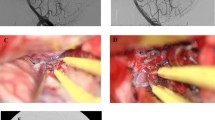Abstract
Background
Multiple AVMs are exceptionally rare lesions and only a few larger series have been published, including other vascular pathologies, such as arterio-venous fistulae (AVF) or patients with hereditary syndromes. Our study presents clinical, angiographic, and therapeutic characteristics of patients harboring sporadic multiple AVMs.
Methods
Basic demographic data, vascular architecture, clinical presentation, treatment strategies, and treatment outcome were analyzed retrospectively from patients with cerebral AVMs treated in our department between 1990 and 2015.
Results
Six out of 539 patients (1.1 %) harbored 15 multiple and distinct cerebral lesions. Nidus size was predominantly small, consequently determining a Spetzler–Martin grade °I–°II (three-tier grading system). In three patients, AVMs shared a proximal feeding artery supply, whereas each AVM displayed its own venous drainage. Five of six patients (83 %) presented with hemorrhage. Four patients received therapy of the AVMs with complete elimination in 3/4 patients (75 %) and 8/9 treated AVMs (89 %). All patients with treatment of the AVM showed good-to-excellent recovery (n = 4, mRS ≤ 2).
Conclusions
Multiple cerebral AVMs are complex vascular lesions. The multiplicity of hemodynamic and malformation-related variables influence treatment strategy and sequence. Thus, awareness of these parameters (of various malformations before and during treatment) is important. The high number of hemorrhagic events in the present series might justify a more aggressive treatment of multiple AVMs than previously thought.





Similar content being viewed by others
References
Bradac O, Charvat F, Benes V (2013) Treatment for brain arteriovenous malformation in the 1998–2011 period and review of the literature. Acta Neurochir 155(2):199–209
da Costa L, Wallace MC, Ter Brugge KG, O’Kelly C, Willinsky RA, Tymianski M (2009) The natural history and predictive features of hemorrhage from brain arteriovenous malformations. Stroke J Cereb Circ 40(1):100–105
Dammann P, Breyer T, Wrede KH, Stein KP, Wanke I, Grams AE, Gizewski ER, Schlamann M, Forsting M, Sandalcioglu IE, Sure U (2014) Treatment of complex neurovascular lesions: an interdisciplinary angio suite approach. Ther Adv Neurol Disord 7(1):60–70
de Sousa AA, Dantas F (1992) Bilateral arteriovenous malformations: case report. Neurosurgery 30(6):940–943
Ericson K, Soderman M, Karlsson B, Guo WY, Lindquist C (1994) Multiple intracranial arteriovenous malformations: a case report. Neuroradiology 36(2):157–159
Faughnan ME, Palda VA, Garcia-Tsao G, Geisthoff UW, McDonald J, Proctor DD, Spears J, Brown DH, Buscarini E, Chesnutt MS, Cottin V, Ganguly A, Gossage JR, Guttmacher AE, Hyland RH, Kennedy SJ, Korzenik J, Mager JJ, Ozanne AP, Piccirillo JF, Picus D, Plauchu H, Porteous ME, Pyeritz RE, Ross DA, Sabba C, Swanson K, Terry P, Wallace MC, Westermann CJ, White RI, Young LH, Zarrabeitia R (2011) International guidelines for the diagnosis and management of hereditary haemorrhagic telangiectasia. J Med Genet 48(2):73–87
Iizuka Y, Rodesch G, Garcia-Monaco R, Alvarez H, Burrows P, Hui F, Lasjaunias P (1992) Multiple cerebral arteriovenous shunts in children: report of 13 cases. Child’s Nerv Syst: Off J Int Soc Pediatr Neurosurg 8(8):437–444
Kim H, Nelson J, Krings T, terBrugge KG, McCulloch CE, Lawton MT, Young WL, Faughnan ME (2015) Hemorrhage rates from brain arteriovenous malformation in patients with hereditary hemorrhagic telangiectasia. Stroke J Cereb Circ 46(5):1362–1364
Kohmura E, Taki T, Tanioka T (1990) Multiple intracerebral arteriovenous malformations in deep structure—case report. Neurol Med Chir 30(8):624–627
Kuo YH, Santoreneos S, Roos D, Brophy BP (2007) Treatment of multiple arteriovenous malformations in pediatric patients with hereditary hemorrhagic telangiectasia and spontaneous hemorrhage. Report of two cases. J Neurosurg 107(6 Suppl):489–494
Miyasaka Y, Nakahara K, Takagi H, Hagiwara H (2003) Development of multiple cerebral arteriovenous malformations documented in an adult by serial angiography. Case report. J Neurosurg 98(1):190–193
Mohr JP, Parides MK, Stapf C, Moquete E, Moy CS, Overbey JR, Al-Shahi Salman R, Vicaut E, Young WL, Houdart E, Cordonnier C, Stefani MA, Hartmann A, von Kummer R, Biondi A, Berkefeld J, Klijn CJ, Harkness K, Libman R, Barreau X, Moskowitz AJ (2014) Medical management with or without interventional therapy for unruptured brain arteriovenous malformations (ARUBA): a multicentre, non-blinded, randomised trial. Lancet 383(9917):614–621
Nakayama Y, Tanaka A, Yoshinaga S, Tomonaga M, Maehara F, Ohkawa M (1989) Multiple intracerebral arteriovenous malformations: report of two cases. Neurosurgery 25(2):281–286
Nishida T, Faughnan ME, Krings T, Chakinala M, Gossage JR, Young WL, Kim H, Pourmohamad T, Henderson KJ, Schrum SD, James M, Quinnine N, Bharatha A, Terbrugge KG, White RI Jr (2012) Brain arteriovenous malformations associated with hereditary hemorrhagic telangiectasia: gene-phenotype correlations. Am J Med Genet A 158A(11):2829–2834
Okada Y, Shima T, Nishida M, Yamane K (1992) Bilateral symmetrical cerebral arteriovenous malformations in the basal ganglia--case report. Neurol Med Chir 32(2):88–92
Perret G, Nishioka H (1966) Report on the cooperative study of intracranial aneurysms and subarachnoid hemorrhage. Section VI. Arteriovenous malformations. An analysis of 545 cases of cranio-cerebral arteriovenous malformations and fistulae reported to the cooperative study. J Neurosurg 25(4):467–490
Putman CM, Chaloupka JC, Fulbright RK, Awad IA, White RI Jr, Fayad PB (1996) Exceptional multiplicity of cerebral arteriovenous malformations associated with hereditary hemorrhagic telangiectasia (Osler–Weber–Rendu syndrome). AJNR Am J Neuroradiol 17(9):1733–1742
Robert T, Blanc R, Botta D, Ciccio G, Smajda S, Redjem H, Fahed R, Piotin M (2016) Management of multiple cerebral arteriovenous malformations in a non-pediatric population. Acta Neurochir 158(6):1019–1025
Salcman M, Scholtz H, Numaguchi Y (1992) Multiple intracerebral arteriovenous malformations: report of three cases and review of the literature. Surg Neurol 38(2):121–128
Sandalcioglu IE, Asgari S, Wende D, van de Nes JA, Dumitru CA, Zhu Y, Gizewski ER, Stolke D, Sure U (2010) Proliferation activity is significantly elevated in partially embolized cerebral arteriovenous malformations. Cerebrovasc Dis 30(4):396–401
Sandalcioglu IE, Wanke I, Zappala V, Forsting M, Sure U (2011) The management of arteriovenous malformations. J Neurosurg Sci 55(1):57–69
Shovlin CL, Guttmacher AE, Buscarini E, Faughnan ME, Hyland RH, Westermann CJ, Kjeldsen AD, Plauchu H (2000) Diagnostic criteria for hereditary hemorrhagic telangiectasia (Osler–Weber–Rendu syndrome). Am J Med Genet 91(1):66–67
Spetzler RF, Martin NA (1986) A proposed grading system for arteriovenous malformations. J Neurosurg 65(4):476–483
Spetzler RF, Ponce FA (2011) A 3-tier classification of cerebral arteriovenous malformations. Clinical article. J Neurosurg 114(3):842–849
Sure U, Butz N, Schlegel J, Siegel AM, Wakat JP, Mennel HD, Bien S, Bertalanffy H (2001) Endothelial proliferation, neoangiogenesis, and potential de novo generation of cerebrovascular malformations. J Neurosurg 94(6):972–977
Sure U, Butz N, Siegel AM, Mennel HD, Bien S, Bertalanffy H (2001) Treatment-induced neoangiogenesis in cerebral arteriovenous malformations. Clin Neurol Neurosurg 103(1):29–32
Tada T, Sugita K, Kobayashi S, Watanabe N (1986) Supra- and infratentorial arteriovenous malformations with an aneurysmal dilatation: a case report. Neurosurgery 19(5):831–834
Utsuki S, Kurata A, Miyasaka Y, Takano M, Ootaka H, Fujii K (2002) Multiple arteriovenous malformations with hemorrhage. Acta Neurochir 144(1):97–101
Willinsky RA, Lasjaunias P, Terbrugge K, Burrows P (1990) Multiple cerebral arteriovenous malformations (AVMs). Review of our experience from 203 patients with cerebral vascular lesions. Neuroradiology 32(3):207–210
Yamashita K, Suzuki Y, Yoshizumi H, Takahashi J, Nogawa T (1993) Multiple cerebral arteriovenous malformations—case report. Neurol Med Chir 33(1):24–27
Yoshimoto T, Kashiwaba T, Houkin K, Abe H (1996) Spontaneous disappearance of arteriovenous malformation during staged treatment of multiple cerebral arteriovenous malformations—case report. Neurol Med Chir 36(11):812–814
Acknowledgments
The authors thank Mike Sucker and Tobias Schoemberg for assistance in preparing the figures.
Author information
Authors and Affiliations
Corresponding author
Ethics declarations
Conflict of interest
All authors certify that they have no affiliations with or involvement in any organization or entity with any financial or non-financial interest in the subject matter or materials discussed in this manuscript.
Ethical approval
All procedures performed in studies involving human participants were in accordance with the ethical standards of the institutional and/or national research committee and with the 1964 Helsinki Declaration and its later amendments or comparable ethical standards.
Informed consent
No IRB approval is needed for retrospective cohorts in academic centers in Germany, so no informed consent was required from any of the patients.
Additional information
Comments
The authors present an interesting series of six patients with multiple AVMs who were managed with variety of treatment strategies including conservative management. While two patients had a very poor outcome, four survived with good/reasonable function. The authors encourage the treatment of patients with multiple AVM based on their apparent higher risk of bleed (which is based on small series of multiple AVMs). They also suggest caution in terms of hemodynamic change in multiple AVMs treatment when one is treated and the other is left alone (whether this increases the risk of bleed or decreases is unclear). Theoretically, one could imagine that multiple AVMs in a given patient will put that patient at higher risk of hemorrhagic event than a patient with a single AVM. On the other hand, treatment of all AVMs has undeniably an accumulated risk of complications, especially if multi-modality treatments are undertaken. I personally lean towards the treatment of multiple AVMs (and more so if one has bled) if the neurological morbidity is considered low or acceptable especially in younger patients. Aruba trial is easily criticized for its non-applicability to surgical treatment of AVMs, and certainly cannot be brought as a validation of observation vs. treatment in multiple AVM scenarios.
Amir Dehdashti
NY, USA
Rights and permissions
About this article
Cite this article
Stein, KP., Wanke, I., Oezkan, N. et al. Multiple cerebral arterio-venous malformations: impact of multiplicity and hemodynamics on treatment strategies. Acta Neurochir 158, 2399–2407 (2016). https://doi.org/10.1007/s00701-016-2989-8
Received:
Accepted:
Published:
Issue Date:
DOI: https://doi.org/10.1007/s00701-016-2989-8




